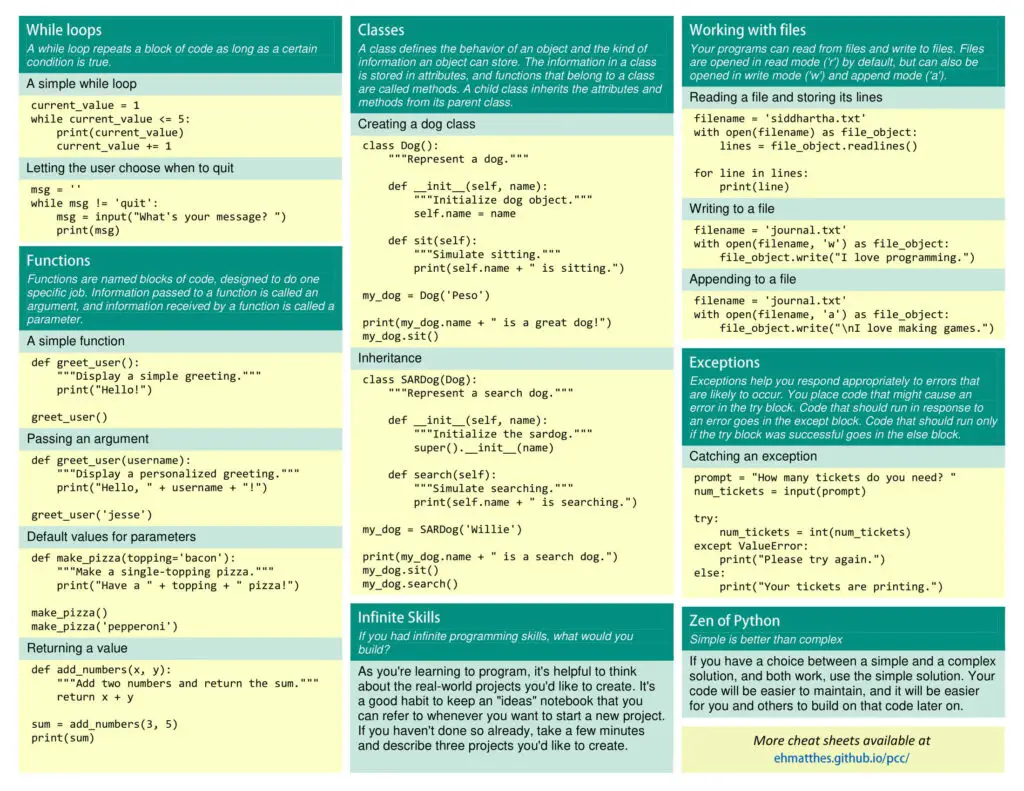Python for Data Science Cheat Sheets. Python is one of the most widely used programming languages in the data science field.Python has many packages and libraries that are specifically tailored for certain functions, including pandas, NumPy, scikit-learn, Matplotlib, and SciPy.The most appealing quality of Python is that anyone who wants to learn it, even beginners, can do so quickly and easily. Welcome to Python Cheatsheet! ☕️ Anyone can forget how to make character classes for a regex, slice a list or do a for loop. This cheat sheet tries to provide a basic reference for beginner and advanced developers, lower the entry barrier for newcomers and help veterans refresh the old tricks.
- 'r' String (converts any Python Object using repro) 's' String (converts any Python object using str) '%' No argument is converted, adds a% character in the end result File Methods close flush fileno isatty next readline (size) xreadlines whence) tell write(str) writelines(sequence) Random Functions Attributes closed encoding.
- Python Language & Syntax Cheat Sheet Python is white-space dependent; code blocks are indented 4 spaces (not tabs) Variable Assignment integer = 1 string = “string” unicodestring = u”unicode string” mutlilinestring = “““ multi-line string ””” tuple = (element1, element2, element3, ) list = element1, element2, element3.

Resources for the second edition are here. I'd love to know what you think about Python Crash Course; please consider taking a brief survey. If you'd like to know when additional resources are available, you can sign up for email notifications here.

Cheat sheets can be really helpful when you’re trying a set of exercises related to a specific topic, or working on a project. Because you can only fit so much information on a single sheet of paper, most cheat sheets are a simple listing of syntax rules. This set of cheat sheets aims to remind you of syntax rules, but also remind you of important concepts as well. You can click here and download all of the original cheat sheets in a single document.
An updated version of these sheets is also available through Leanpub and Gumroad. The updated version includes a sheet that focuses on Git basics, a printer-friendly b&w version of each sheet, and each sheet as a separate document. The updated versions are available at no cost on both platforms.
Individual Sheet Descriptions

- Beginner’s Python Cheat Sheet
- Provides an overview of the basics of Python including variables, lists, dictionaries, functions, classes, and more.
- Beginner’s Python Cheat Sheet - Lists
- Focuses on lists: how to build and modify a list, access elements from a list, and loop through the values in a list. Also covers numerical lists, list comprehensions, tuples, and more.
- Beginner’s Python Cheat Sheet - Dictionaries
- Focuses on dictionaries: how to build and modify a dictionary, access the information in a dictionary, and loop through dictionaries in a variety of ways. Includes sections on nesting lists and dictionaries, using an OrderedDict and more.
- Beginner’s Python Cheat Sheet - If Statements and While Loops
- Focuses on if statements and while loops: how to write conditional tests with strings and numerical data, how to write simple and complex if statements, and how to accept user input. Also covers a variety of approaches to using while loops.
- Beginner’s Python Cheat Sheet - Functions
- Focuses on functions: how to define a function and how to pass information to a function. Covers positional and keyword arguments, return values, passing lists, using modules, and more.
- Beginner’s Python Cheat Sheet - Classes
- Focuses on classes: how to define and use a class. Covers attributes and methods, inheritance and importing, and more.
- Beginner’s Python Cheat Sheet - Files and Exceptions
- Focuses on working with files, and using exceptions to handle errors that might arise as your programs run. Covers reading and writing to files, try-except-else blocks, and storing data using the json module.
- Beginner’s Python Cheat Sheet - Testing Your Code
- Focuses on unit tests and test cases. How to test a function, and how to test a class.
- Beginner’s Python Cheat Sheet - Pygame
- Focuses on creating games with Pygame. Creating a game window, rect objects, images, responding to keyboard and mouse input, groups, detecting collisions between game elements, and rendering text.
- Beginner’s Python Cheat Sheet - matplotlib
- Focuses on creating visualizations with matplotlib. Making line graphs and scatter plots, customizing plots, making multiple plots, and working with time-based data.
- Beginner’s Python Cheat Sheet - Pygal
- Focuses on creating visualizations with Pygal. Making line graphs, scatter plots, and bar graphs, styling plots, making multiple plots, and working with global datasets.
- Beginner’s Python Cheat Sheet - Django
- Focuses on creating web apps with Django. Installing Django and starting a project, working with models, building a home page, using templates, using data, and making user accounts.
Python Syntax Guide
Available from No Starch Press and Amazon.
